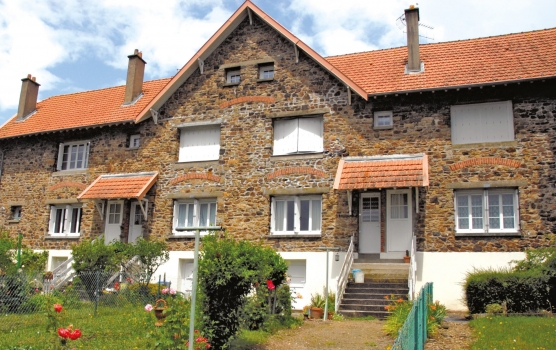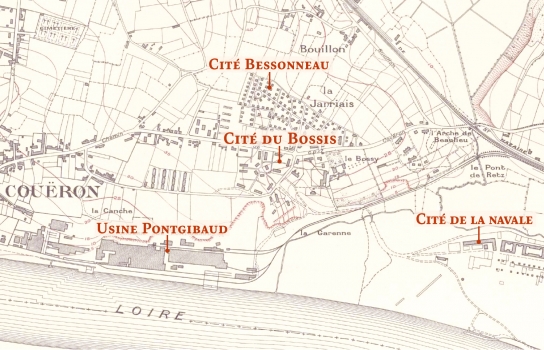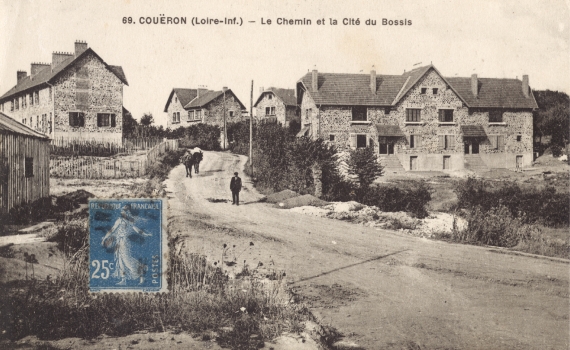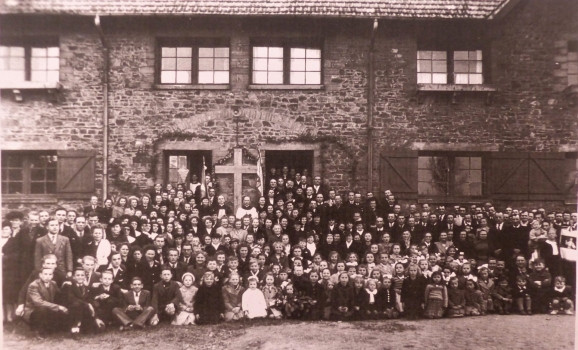The Bossis
A remarkable company town
Built to house the workers of the Couëron and Basse-Indre factories, the Bossis company town welcomed families from all over Europe but mainly from Poland, creating a community that is still active today.
A site overlooking the Loire
The Bossis company town was built close to the Garenne quarry where a lead foundry was set up in 1861. In the 19th century, the Bossy farm dominated the branch of the Loire from Basse-Indre to Couëron.
This part of Couëron was transformed by the large-scale developmental works of the Loire and by the industrial development at the end of the 19th century.
The economic recovery after World War 1
The increasing development of factories on the (Lower) Loire reinforces the need for more workers. The First World War saw the arrival of workers from the colonies, and women, in the factories.
After the war, industrial activity continued its development. The 1919 accords facilitated the arrival of Polish workers throughout France.
« We had a garden, my father raised chickens and rabbits. We had some potatoes, some other vegetables as well, mainly cabbage. » Anna
A town and its gardens
The 288 stone houses of the Bossis and the small wooden houses of Bessonneau were allocated as they became available. The company town stretched from the Garenne quarry to the Pont-de-Retz. The housing was rented at a low price and the maintenance was ensured by the company.
The company town offers an inspirational architectural quality reminiscent of the English garden-cities. It shows its unity through the use of gneiss rubble stone masonry, from the Garenne quarry, tiles, concrete window-frames and woodwork.
The housing was small for large families and for a long period there were neither toilets nor running water. The vegetable gardens were essential in aiding with the provision of food.
The parish and the Polish school
The vast majority of the Polish families were practising Catholics. The religious festivals held by a Polish priest played an important role in the life of the neighbourhood. Children attended the Polish school until their entry into elementary school. There they began to learn French while still attending the Polish school on Thursdays and in the evenings.
A difficult but joyous life!
The Polish community was initially constituted by male workers, who were subsequently joined by their wives and children. The voyage was tiring and could last 7 days.
The community was closely-knit, particularly given that learning French was a difficult task.
Often, it was the children who acted as interpreters.
« The Bossis was a place where everyone knew each other. »
Lucja
Social life revolved around the café, the cinema, the concert venue and ballroom. Each day, the women grouped together at the cooperative created by the Foundries, or at the pump and the wash-house. Sunday Mass, religious festivals and the annual fête brought the community together. Sports, in particular football, drama, or the choral society were integral parts of children’s leisure activities. During the summer, the children would frequent the banks of the Loire where the most daring would bathe, not without risk.
The Bossis today
The company town has evolved since its construction: the inhabitants have diversified even though the Polish remained numerous for many years. A part of the houses were sold, the rest were replaced by small blocks of flats. Since 2018, the SAMO, a social housing agency, has undertaken a renewal of its accommodation: 15 houses have been pulled down to allow for the construction of new accommodation while the others have been renovated.
| 1919 | The Franco-Polish accord of 3rd September, 1919, organises the recruitment of Polish workers; the Carnaud Company brings them to Basse-Indre.
Establishment of the organisation « The Company Town of the Basse-Indre Foundries ». |
| 1920-1923 | Construction of the company towns of the Bossis, the Chabossière, and Bessonneau. |
| 1923 | Arrival of the first Polish immigrants in Couëron. Polish immigration will continue to rise until the 1930s. |
| 1924 | Creation of the first Polish school. |
| 1929 | Creation of the Polish parish. |
| 1939 | The Second World War puts an end to immigrating to France for work and also leaves people unable to return to their homelands. |
| 1940-1944 | Numerous inhabitants of Couëron, who had immigrated there, join the resistance, such as
Jan Niescierewicz or Sister Barbara, a Polish nun. |
| 1977 | The company town becomes the property of the SAMO, a social housing agency. |
| 1981 | The main street that runs through the town is given the name « Jan Niescierewicz », a resistance fighter killed by the Germans in Saint-Herblain on the 9th July, 1944. |
| 2018 | The first foundation stone to inaugurate the renovation project is laid by the SAMO. |




